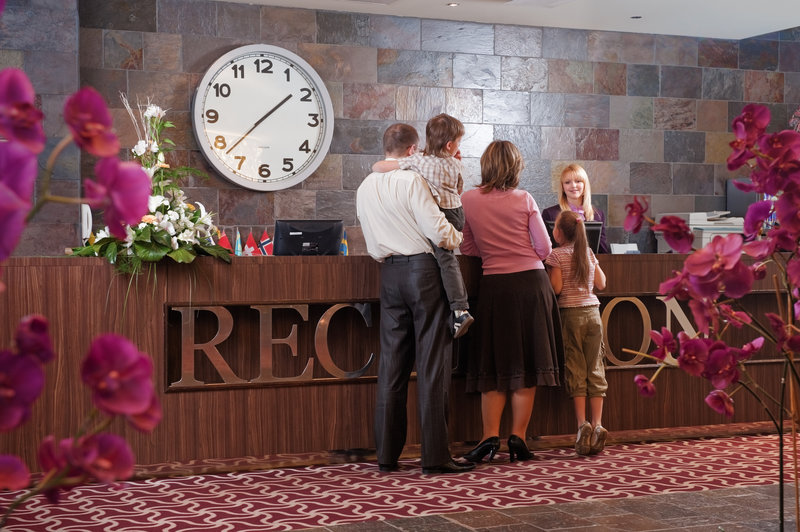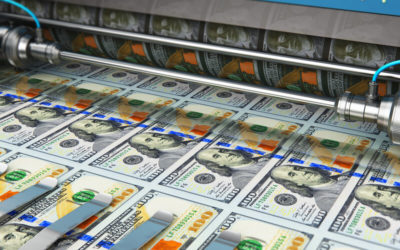There are plenty of statistics supporting the effectiveness of personalized marketing. So many, in fact, that if you were to summarize them into one statement, it would tell you, in ALL CAPS, that you HAVE to use personalized marketing. That is if you want to make more money and contend in the ultra-competitive hospitality industry. As a savvy hotel marketer, you want numbers to back up that claim. So that’s what we’re about to do. Here’s how personalized marketing helps your hotel make more money.
The Travel and Hospitality Industry is Thriving

If you go back to 2009, the first travel apps were just getting started. If you wanted a taxi, you hailed a taxi. You didn’t summon an Uber because nobody knew what it was yet. And Lyft didn’t even exist.
Additionally, small luxury hotels were some of the only businesses in the travel industry that could create personalized experiences for their guests. How the times have changed—in a relatively short span, too.
The hospitality industry is thriving. That’s the good news. The bad news is there’s a ton of competition. There are more than 270 trademarked brands—plus a slew of independent hoteliers—around the world. So for all your optimism (you’re part of a prosperous industry), you also know that you’ll need to work smarter to get consumers to choose your hotel. It stands to reason that you need an advantage to help determine whether a customer chooses your hotel or someone else’s. Personalized marketing is your advantage.
Personalized Marketing: Hotel Guests Demand Personalization
If you take only one thing from this article, know that your customers want personalization. Actually, they don’t just want it. They demand it. Personalization is a marketing strategy that helps your brand increase emotion and engagement among your customers. That means you’ll gain their trust and eventually you’ll boost your sales. When you know where in the world your customers are, literally, and you know their demographics and their reasons for doing business with you, you have very valuable information at your disposal. Use it to improve how you communicate with them and how you solve their problems.
Earlier, we said there were a lot of statistics to support personalization. Well, here are a select few of them that are particularly impressive.
- Over 90% of consumers are more apt to shop with brands that give them offers and recommendations relevant to their interests.
- 72% of consumers will only respond to marketing messages that fit their interests.
- Almost 40% of consumers think brands should offer more personalization with their marketing messages.
- About 90% of consumers are happy to share their behavioral data—if that means they’ll get additional benefits to make their shopping experiences cheaper and/or easier.
- About 92% of marketers say they use personalization techniques in their marketing, yet only 55% of them felt like they had the necessary customer data to pull it off successfully.
With all these supporting numbers, is it any wonder hotel brands are trying to give their customers what they want? The travel and hospitality industry shows the largest turn towards personalization, with modern-day marketers applying the technique to over 60% of their communications.
So now that you know about personalized marketing, here’s how you can use it.
Here Are 5 Ways You Can Personalize Your Brand’s Hotel Marketing
We’ve established that personalized marketing is gaining momentum and that it’s good for your hotel brand. But how do you get the ball rolling to make it happen? Let’s look at the various ways you can achieve personalization—and make more money.
1. Fix Your Personalized Marketing Problems with Customer Data

With customer data basics—like contact information, demographics, and purpose of stay—you’ve got important details about your guests that can work for you. Now you can personalize your email blasts, landing pages, and direct mail campaigns. With more information, you can further personalize their stay. Ask yourself these questions:
- What time do they typically arrive and leave?
- Do they usually bring guests with them?
- Where are they traveling from?
- Are they spending money on extras?
- Is there a restaurant at your hotel? Do they dine there?
- Do they make use of the pool or fitness facilities?
When you know their preferences, you can create offers just for them based on different profiles. Let’s look at an example.
If Richard Snippet books a four-night business trip every other month, you can personalize his trips to keep him happy. That way, when he arrives, you can have some of his favorite things in place. Aside from the aforementioned marketing materials, look into his requests and check-ins when he’s at your hotel. If he makes the same ones regularly, have those amenities or services in place in advance so he doesn’t need to ask for them each time. You’ll impress him by the fact that you noticed.
2. Focus on the Customer (Guest) Experience

Joey appreciated the effort and he was grateful for the special attention—as opposed to being treated as just another guest family. “It was a great way to start the relationship,” Joey said.
That’s one of the many possibilities when it comes to making a personal connection with your guests. By simply observing them, you’ll get great data points so you can customize their experience and take it from good to remarkable. You’ll turn them from hotel guests into promoters. Using this particular case as an example, the key to Joey’s heart was through his children, which is often the case. With that in mind, you should always strive to:
- Develop a customer relationship from the beginning that’s based on trust.
- Seek feedback before (targeted messages), during (recommendations based on preferences), and after (automated emails) your customer’s stay.
- Make sure your manager monitors your guests’ behaviors so you can provide the very best service.
Notice your guests and pay attention to their habits, but don’t stalk them. You don’t want to turn a moment of personalization into something weird or creepy. People are already paranoid about being followed around the web with remarketing techniques. Don’t give them the real-life version inside your hotel.
3. Analyze and Delight via Social Media, Apps
Consider all the free feedback that’s available to you via social media. From Facebook and Twitter to Expedia, Travelocity, TripAdvisor, and many other travel apps, you have access to a plethora of detailed information about your own hotel and/or hotels in general. Consumers are happy to voice their opinions about things they like, dislike, or that they wish existed, etc. Analyzing this information allows you to capitalize upon it.
Hopefully, after doing some research, you’ll be able to answer these questions.
- What do your customers like or dislike about your hotel?
- What words do they use most often in reviews?
- Do you see any trends?
- How do you compare to your closest competitors?
- Where can you improve?
The more you know about what consumers are looking for in a hotel experience, the better you can give them what they want. Monitor your reviews, answer questions, solve problems, and develop a transparency that shows you have nothing to hide. When you do all of these things, it will show how attentive you are to your customers’ needs and it will prove that you care.
4. Geotargeting: Right Audience, Right Time, Right Message

Location-based marketing, aka geotargeting or geofencing, is the process of targeting different content to consumers based on their location. For instance, you can show content to consumers based on where they are in the world. You can target their precise location, region, country, state, zip code, or any other positional data, depending on your goals. Geofencing is a similar strategy but it uses a mobile device’s GPS data to target marketing messages to users that are in a particular area.
Geotargeting and geofencing are effective strategies and the statistics are promising. Research from Google shows that over 60% of smartphone users would rather buy from brands that customize their websites for location.
So how can your hotel use geotargeting? Consider this possibility. If you’re located near an airport, you could create a mobile marketing campaign that targets travelers who are looking for a room because of a cancelled flight. For this type of campaign, you’d need to have access to flight cancellation data and weather conditions. If you have a hotel near an airport that has frequent flight cancellations (we’re looking at you LaGuardia), you could create an entire campaign that would solve people’s travel problems by providing a nearby room.
5. Personalize Your Hotel’s Direct Mail with Variable Data Printing

Variable data printing allows you to personalize every aspect of your direct mail campaign from one printed piece to the next. That means you can change the text, graphics, and images of your mailing without slowing down the printing process.
Let’s look at an example. Imagine you’re preparing a new marketing campaign for summer vacation deals at your hotel. First, you’ll want to use each customer’s name in the piece. In doing so, you can boost your response rates by more than 130%, so that point of personalization is a given. Just do it.
But you could also personalize your offers based on how much money a customer has previously spent at your hotel. That way, loyal patrons that spend more will receive a larger incentive as a VIP customer. From the type of room typically booked to the customer’s favorite vacation spots and times, if you have the data, VDP has the technology to help you build a personalized connection.
Keep in mind that personalization doesn’t begin and end with the inside of your direct mail piece. You can learn how to optimize your direct mail letter. But the envelopes (assuming you’re not sending a self-mailer) can also provide a level of successful personalization—in full variable color, no less. That’s the future of personalized mail. For example, consider using handwriting on the envelope. It’s 300% more likely to be opened. You can also try window envelopes that show through to the personalization inside.
MSP Helps You Personalize Your Hotel’s Direct Mail Marketing
A third of marketers agree that personalization is the one capability that’s most important to their future marketing efforts. Yet almost 85% of them say it’s their biggest challenge. We have the answers. MSP can help you personalize your hotel marketing with direct mail solutions that will help you drive sales and stay ahead of your competitors. Let’s have a conversation about your marketing goals and where direct mail fits in. Contact an MSP representative today and let’s get started on a marketing plan that will work for your hotel.
How Effective is Direct Mail Marketing?
As a smart marketing professional, you know that direct mail is a wise choice to include in your multichannel arsenal. But exactly how effective is direct mail marketing? We're here to answer that question for you. Direct Mail Marketing Continues to Grow ...
How to Optimize Your Direct Mail Postcards
Marketers from every industry love direct mail postcards because they're affordable and effective ways to advertise their products and services. So we applied our 65+ years of knowledge and came up with a few tricks you can use to boost your results. Here's how to...
Direct Mail Advertising Costs: Here’s What to Look For
Marketers want to know how to get the best return for their advertising dollars. So we assembled the typical direct mail costs to show you what's involved and what options you'll have when it's time to plan your next direct mail campaign. Direct Mail...





